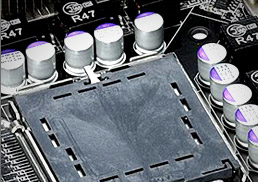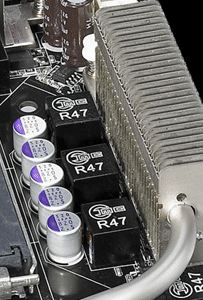Asus P5N32-SLI: Dual x16 - What Dreams Are Made On . . .
by Gary Key on October 27, 2005 12:05 AM EST- Posted in
- Motherboards
This line as spoken by the magician Prospero in William Shakespeare's whimsical play, "The Tempest", reminds us of the uniqueness of the human mind and the fleeting amount of time that we are around to utilize it."We are such stuff, As dreams are made on and our little life
Is rounded with a sleep..."
The Asus P5N32-SLI Deluxe that we will review today is also very unique in several ways and like most computer products in the current marketplace, its life span will be fleeting. However, for those of you who have the opportunity to utilize it, you will find what dreams are made on.
I will say this up front; this is one of the better motherboards that I have had the opportunity to use in the last 20 years. In fact, this board deserves additional testing time in order to explore fully and extract all of its performance potential. In keeping with what we believe is the best option for the current Intel processor lineup, the Pentium D series, we did not test a single core processor on this board. However, based upon the results that we extracted from the 840EE and 820D processors, we will be testing a single core processor on this board in the near future.
While it does not have the quad graphics capability of the Gigabyte GA-8N SLI Quad, the stellar layout of the MSI P4N Diamond, or the extensive feature set of the Gigabyte GA-8I955x Royal that was reviewed recently, this board's capability more than exceeds the sum of its parts. Yes, it does have some quirks as most products will, but Asus has engineered a truly remarkable motherboard utilizing the revised NVIDIA nForce4 Intel Edition SLI for the Northbridge and the NVIDIA nForce4 SLI for the Southbridge resulting in the x16 designation.


 |
 |
One of the main design features that Asus engineered into this board is an exclusive 8-phase voltage regulator power design that can significantly lower operating temperatures while reducing input ripple current and output ripple voltages . In fact, the input ripple current is over three times lower than a traditional 4-phase design while output ripple voltages are four times lower. The power consumption compared to the 4-phase design is about 10% less while the 8-phase design has the advantage of quicker transient responses and increased dependability due to lower thermal values.
What all this means is that your system will run cooler and overclock better compared to other solutions. In fact, through informal testing utilizing the BIOS readings, we found our Intel Pentium 840EE was on average running about 5c cooler in the Asus board compared to other solutions in the same test setup and ambient conditions. We will be conducting more thermal tests with scientific instrumentation in the near future. Our average overclocks were around 5% better than the other boards at more aggressive memory timings and with lower voltages required to the chipsets. While this does not sound like much, the ability of this board to run a CPU that previously topped out in the 3.9GHz range at up to 4.2GHz is impressive. The Asus P5N32-SLI Deluxe was an extremely stable board throughout our testing and did not fail a single time throughout two weeks of varying tests and conditions.
Let's see what this board is capable of now.










70 Comments
View All Comments
scottyfree111 - Friday, December 16, 2005 - link
Gary, I got one of the first production runs of this board and I smelled something burning on the first post. I got it to work, but mobo temps were 46-48C. my friend got the same board a few weeks later in an almost identical setup (P43.46EE, dual Quadro FX-3400's, PC P&C 850 PSU) and got 28C mobo, and 29C (idle on the CPUw/Zalman 9500 cooler). So I RMA'd it, and am hoping for similar results. It should be back any day now and I'm hoping they replaced it. Asus forums list many unhappy campers having all sorts of Bios issues. Which Bios are you using now(212 maybe?) Also, I was disappointed that there are only 5 internal sata ports since I use 9 hard drives. I've been looking into using a Sil Image 5X1 port multiplier with a 4 bay esata enclosure from either Addonics or Cool Drives to get a RAID 0X4 on the Sil 3132 with my 4 WD740 Raptors for video capture/editing. Do you know anything about setting up an esata RAID? ThanksMadAd - Friday, November 4, 2005 - link
Thanks for the reply Gary, dont bust a gut though, 1920x1440 is really good enough :)Im just welcoming the recognition that people do use high res to do normal things like play games on (shock horror).
Ive always found it strange that Anandtech reports on so much cutting edge hardware in the cpu, mobo and video areas, the bread and butter of a good review site, but seemed to ignore people with high end monitors in test results - at least you are putting that right now, thank you again.
MadAd - Wednesday, November 2, 2005 - link
Hooray! a reviewer that benchmarks games up to high end video resolutions! Thank you thank you!!My own resolution of 1920x1200 wasnt mentioned but I got the picture from what you did cover, thank you again- The other Anand reviewers seem to think theres no life after 1600x1200. (but there is :¬) )
Nice one
Gary Key - Wednesday, November 2, 2005 - link
Hi,The review results will depend upon the monitor's capability during testing (several of my monitor's only go to 1600x1200 or 1280x1024). Also, please realize that a large majority of readers have 19" LCDs that only support up to 1280x1024. This is why we standardized on this resolution recently. However, we will start providing higher resolution benchmarks depending upon the hardware being reviewed (performance oriented boards) and time allowances. This is based upon the fact that the next step up for most buyers will be the 1600x1200 ~ 1920x1200 capable monitors.
The higher end monitor's I have for testing do not support the 1920x1200 format. They support the 1920x1440 and up resolutions. However, that should change in the next month or so hopefully. ;-)
I appreciate the comments and hopefully we can get you and others some 1920x1200 benchmarks in the near future.
Thanks!
H0witzer - Saturday, October 29, 2005 - link
As the owner of a P5ND2-SLI-Deluxe I have to say the C19 chipset gets WAY too hot. Not to mention the horrible stability of the BIOS. There has been Many complaints from ASUS owners about these issues. Another issue as of late has been power supplies blowing. I personally experience a 3 day old 500W Aspire power supply blowing, and after flashing the BIOS the entire system dying.I wonder about the stability of the NVIDIA chipset and how it will hold up in the long run. I would have liked to see a comparison against the P5WD2-Premium.
Gary Key - Saturday, October 29, 2005 - link
I have read some of the horror stories about the P5ND2-SLI-Deluxe and agree about the thermal issues among others with the A2 stepping of the C19. The A3 and up steppings are better in this regard and the new board layout is significantly more robust than the P5ND2 series. I believe Asus realized their errors from several product releases lately (I went to Intel boards after an earlier issue with Asus) and are in the process of correcting them. This board has restored my faith in their new product lineup. This bios we tested with (0047) has been wonderful from both a stability and performance viewpoint. I personally use OCZ or PC Power and Cooling power supplies and have never had an issue with any board, good or bad. I did not have the P5WD2 to test against but I do have the P5LD2 now. :->H0witzer - Sunday, October 30, 2005 - link
Hey Gary,Thanks for taking the time to write back. Based on your article and statements here I am going to contact my online retailer who is processing my RMA and tell them to just issue a credit and I will purchase the P5N32-SLI instead. Don't worry i won't hold you responsible for my decision :-)
I just figured it couldn't be any worse than the last board. Hopefully they fixed the things that were issues with the P5ND2-SLI Deluxe.
One last question, when will this be available, have you heard anything yet? All the online retailers are saying Pre-Order.
Gary Key - Sunday, October 30, 2005 - link
Good Day,I bought a couple of boards from NewEgg last week but I noticed this morning they are out of them. I will send them a message and see when their next batch is in. When you receive the board please email me and we can discuss specifics on the board and bios. I really think you will be pleased with this board. If not, please post your issues. I would appreciate another viewpoint or opinion on the board.
H0witzer - Wednesday, November 2, 2005 - link
Hi Gary,Any word on why the boards all disapeared? Seems that No one has them anymore.
Gary Key - Wednesday, November 2, 2005 - link
Good Day,We spoke with Asus tonight. The second production run of boards was slightly delayed due to a couple of minor hardware changes on the board that should not affect performance. They changed resistors in a couple of areas apparently. However, Asus will provide us a new board for testing to ensure results are indicative of the review board results. The next production run of boards should arrive within 7 business days according to our sources. I will post an update to the article if there are any changes with this new release.
Thanks....